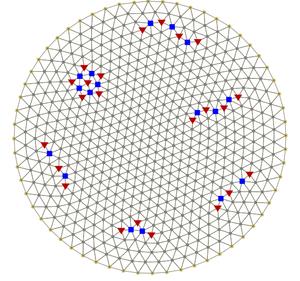A Wigner crystal is the solid (crystalline) phase of electrons first predicted by Eugene Wigner in 1934. A gas of electrons moving in 2D or 3D in a uniform, inert, neutralizing background will crystallize and form a lattice if the electron density is less than a critical value. This is because the potential energy dominates the kinetic energy at low densities, so the detailed spatial arrangement of the electrons becomes important. To minimize the potential energy, the electrons form a b.c.c. (body-centered cubic) lattice in 3D, a triangular lattice in 2D and an evenly spaced lattice in 1D. Most experimentally observed Wigner clusters exist due to the presence of the external confinement, i.e. external potential trap. As a consequence, deviations from the b.c.c or triangular lattice are observed. A crystalline state of the 2D electron gas can also be realized by applying a sufficiently strong magnetic field. However, it is still not clear whether it is the Wigner-crystallization that has led to observation of insulating behaviours in magnetotransport measurements on 2D electron systems, since other candidates are present, such as Anderson localization.There is a single dimensionless parameter characterising the state of a uniform electron gas at zero temperature, the so-called Wigner-Seitz radius rs = a / ab, where a is the average inter-particle spacing and ab is the Bohr radius. Quantum Monte Carlo simulations indicate that the uniform electron gas crystallizes at rs = 106 in 3D and rs = 31 in 2D.For classical systems at elevated temperatures one uses the average interparticle interaction in units of the temperature: G = e2 / (kB Ta). The Wigner transition occurs at G = 170 in 3D and G = 125 in 2D. It is believed that ions, such as those of iron, form a Wigner crystal in the interiors of white dwarf stars.More generally, a Wigner crystal phase can also refer to a crystal phase occurring in non-electronic systems at low density. In contrast, most crystals melt as the density is lowered. Examples seen in the laboratory are charged colloids or charged plastic spheres.In practice, it is difficult to experimentally realize a Wigner crystal because quantum mechanical fluctuations overpower the Coulomb repulsion and quickly cause disorder. Low electron density is needed. One notable example occurs in quantum dots with low electron densities or high magnetic fields where electrons will spontaneously localize in some situations, forming a so-called rotating "Wigner molecule", a crystalline-like state adapted to the finite size of the quantum dot.Wigner crystallization in a two-dimensional electron gas under high magnetic fields was predicted (and was observed experimentally) to occur for small filling factors (less than ν=1/5) of the lowest Landau level. For larger fractional fillings, the Wigner crystal was thought to be unstable relative to the fractional quantum Hall effect (FQHE) liquid states. The recent observation of a Wigner crystal in the immediate neighborhood of the large fractional filling ν=1/3 was unexpected, and has led to a new understanding (based on the pinning of a rotating Wigner molecule) for the interplay between quantum-liquid and pinned-solid phases in the lowest Landau level. Another experimental realisation of the Wigner crystal occurs in single electron transistors with very low currents, where a 1D Wigner crystal will form. The current due to each electron can be directly detected experimentally.Additionally, experiments using quantum wires - short quantum wires are sometimes referred to as ‘quantum point contacts’, (QPCs) - have also led to suggestions of Wigner crystallization in 1D systems.In the experiment performed by Hew et al., a 1D channel was formed by confining electrons in both directions transverse to the electron transport, by the bandstructure of the GaAs/AlGaAs heterojunction and the potential from the QPC. The novel device design allowed the electron density in the 1D channel to be varied relatively independently of the strength of transverse confining potential, thus allowing experiments to be performed in the regime in which Coulomb interactions between electrons dominate over the kinetic energy. It is a well-established result that the conductance through a QPC shows a series of plateaux quantized in units of the conductance quantum, 2e2/h However, this experiment reported a disappearance of the first plateau (resulting in a jump in conductance of 4e2/h), which was attributed to the formation of two parallel rows of electrons. In a strictly 1D system, electrons will occupy equidistant points along a line, i.e. a 1D Wigner crystal. As the electron density increases, the Coulomb repulsion becomes large enough to overcome the electrostatic potential confining the 1D Wigner crystal in the transverse direction, leading to a lateral rearrangement of the electrons into a double-row structure. The evidence of a double row observed by Hew et al. may point towards the beginnings of a Wigner crystal in a 1D system.




Commenter
0